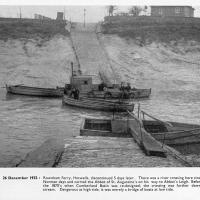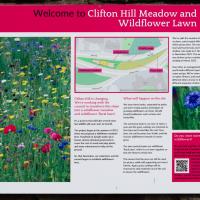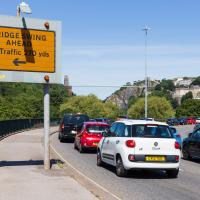Tagged: when
I mostly went out to hang out with my friends Sarah and Vik in Bedminster, but along the way I thought I'd take a closer look at something a little nearer home: the last crossing point of the Rownham Ferry.
And here's the picture that inspired this little local visit today. A week or so back I was browsing the boxes of books at Rachel's and Michael's Antiques on Princess VIctoria Street, and flipping through their collection of Reece Winstone books. Winstone's famous Bristol As It Was series are an amazing documentary source created by a man who loved both photography and Bristol and effectively became Bristol's foremost documentary photographer for decades. A lot more of Bristol's history is visible today because of him.
In the Bristol As It Was 1939 - 1914 book I saw this picture of the Rownham Ferry. Unfortunately the book was a first edition and priced at £20, so I ordered a cheaper edition from an independent dealer in Stockport when I got home! (Let's consider that as me leaving the rare first edition for the true connoisseurs, rather than just being cheap.)
Here we see the ferry just five days before its closure on the last day of 1932. Looking closely, it seems to be perhaps operating as a reaction ferry, with the boat tethered to a static line across the river, and the ferryman using the rudder to turn the boat and use the power of the flowing water to shuttle the boat from side to side. Clever!
Photo © Reece Winstone Archive. (I recommend buying the books if you like old photos of Bristol. They're amazing!)
Tags: Bristol Places UK onemilematt united kingdom river avon avon new cut Spike Island history Rownham Ferry
Auto-Tags: Boat Water Watercraft Vehicle Naval architecture Boats and boating--Equipment and supplies Ship Motor vehicle History Monochrome Water transportation Stock photography Lake Monochrome photography Sky
Text Recognition Tags: (63) 26 December 1932 : Rownham Ferry, Hotwells, discontinued 5 days later. There was a river crossing here since Norman days and carried the Abbot of St. Augustine's on his way to Abbot's Leigh. Before the 1870's when Cumberland Basin was re-designed, the crossing was further down- stream. Dangerous at high tide, it was merely a bridge of boats at low tide. (63) 26 December 1932 : Rownham Ferry, Hotwells, discontinued 5 days later. There was a river crossing here since Norman days and carried the Abbot of St. Augustine's on his way to Abbot's Leigh. Before the 1870's when Cumberland Basin was re-designed, the crossing was further down- stream. Dangerous at high tide, it was merely a bridge of boats at low tide.
Easter Monday Gardens and Flowers
18 Apr 2022
I didn't really set out with a theme of flowers and gardens in mind for this walk. I just fancied heading up to Clifton Village to get lunch. As it turned out, though, Spring was springing, so a minor theme emerged as I started off with the graveyard flowers of Hope Chapel and wandered up to see the beginnings of the new wildflower garden at Clifton Hill Meadow.
Tags: Bristol Places UK onemilematt united kingdom Clifton Village Clifton Clifton Hill Clifton Hill Bank Clifton Hill Meadow
Auto-Tags: Plant community Ecoregion Plant Green Natural landscape Natural environment Botany Organism Terrestrial plant Vegetation Land lot Grass Font Biome Line
Text Recognition Tags: Welcome to Clifton Hill Meadow and Wildflower Lawn We to add which grobe Theate h how to w 2001. The c wakenya March 2002. Over t 0 flow and fy ata of t What will happen on the site Clifton Hill is changing We're working with the council to transform this slope www into a wildflower meadow and wildflower floral law. betrie Espress but we will soon stat The week and the grap prothesof 2011 Feyete the C when we propawower made the becomes to fe of powiad of coa tour, de dona pm the cap sed my led to help on the gord They are w Swach the So that owner, and the ம து போட்ட விலொ That the be wh Apinating w the to the we Do you want mor wildflowers? DVD WEST BRISTOL CLIMATE Welcome to Clifton Hill Meadow and Wildflower Lawn We to add which grobe Theate h how to w 2001. The c wakenya March 2002 . Over t 0 flow and fy ata of t What will happen on the site Clifton Hill is changing We're working with the council to transform this slope www into a wildflower meadow and wildflower floral law . betrie Espress but we will soon stat The week and the grap prothesof 2011 Feyete the C when we propawower made the becomes to fe of powiad of coa tour , de dona pm the cap sed my led to help on the gord They are w Swach the So that owner , and the ம து போட்ட விலொ That the be wh Apinating w the to the we Do you want mor wildflowers ? DVD WEST BRISTOL CLIMATE
I've been pretty awful at reading so far this year, apparently averaging about one book per month. That's a far cry from 2019, say, where I got through 41 books in the year. Today's wander was prompted by my rubbish reading, as I needed to go hand back some books to the library, because I'd managed to renew them so many times that I hit the limit on renewals. Oops. Several of them were still unread.
So, off to the Central Library for me, tail between my legs. On the way there I did my best to recreate a historical photo of Dowry Square; while I was in the area I walked under the adjacent Norman arch and poked around behind the Cathedral, and I also had a little diversion to the city centre and came back along the south side of the river, hitting some trouble with the lock gates as I finally crossed the harbour back towards home.
Tags: Bristol Places UK onemilematt united kingdom City Centre St Augustine's Cathedral Choir School Cathedral School college square
Auto-Tags: Font Rectangle Pink Material property Magenta Publication Pattern Wood Carmine Paper Paper product Commemorative plaque Signage Circle History
Text Recognition Tags: Abbot's Gatehouse Bristol Cathedral originated as a monastery founded in the 1140s by Robert Fitzharding (later Lord Berkeley) This archway formed the entrance to the abbey's residential buildings One of the finest examples of Romanesque architecture in the west country, the arch was carefully preserved when, in the fifteenth century, the two-storey gatehouse was constructed over it. The medieval statues on the gatehouse depict key individuals in the history of the abbey, which was disbanded in 1539. Bristol Cathedral was founded in 1542 and the gatehouse today contains its administrative offices. Bristol Cathedral Entrance to the cathedral is via the North Porch through the arch and to the right SHAND 200 ACER B HODERN Abbot's Gatehouse Bristol Cathedral originated as a monastery founded in the 1140s by Robert Fitzharding ( later Lord Berkeley ) This archway formed the entrance to the abbey's residential buildings One of the finest examples of Romanesque architecture in the west country , the arch was carefully preserved when , in the fifteenth century , the two - storey gatehouse was constructed over it . The medieval statues on the gatehouse depict key individuals in the history of the abbey , which was disbanded in 1539 . Bristol Cathedral was founded in 1542 and the gatehouse today contains its administrative offices . Bristol Cathedral Entrance to the cathedral is via the North Porch through the arch and to the right SHAND 200 ACER B HODERN
A bit more detail if you fancy it.
Tags: Bristol Places UK onemilematt united kingdom City Centre Saint Nicholas Market St Nicholas Market St. Nicholas Market Corn Street old city
Auto-Tags: Wood Font Wall Landmark Commemorative plaque Tree History Signage Memorial Metal Public utility Interior design Kitchen utensil Idiophone
Text Recognition Tags: THE CORN EXCHANGE CLOCK The clock on this building with an extra minute hand recalls early Victorian days, when Bristol was in two minds about the correct time. Although today we take Greenwich Mean Time or British Summertime for granted before 1880 no standard time existed in the British Isles. Every city had its own local time, reckoned by the sun and signed by church bells. Bristol lies 2 degrees, 36 minutes west of the Greenwich Meridian and so the sun reaches its noon nearly peak 11 minutes later than in Greenwich. Before the growth of railways, most people expected to spend their lives close to home. Travel by stagecoach or ship was slow and uncomfortable. Timetables were vague. For Bristolians a change came in June 1841, when the first through train from London pulled into Temple Meads Station. Brunel's Great Western Railway began to tempt people to travel, now they could go to London in hours rather than days. The Railways ran on London time (Greenwich Mean Time). If you wanted to catch a train at noon from Temple Meads you had to remember that it would pull out at 11:49 Bristol Time. To help Bristolians catch their trains, Bristol Corporation arranged for the main public clock on the Corn Exchange to show both local and Greenwich Mean Time (Railway Time) with two minute hands. Other clocks in Bristol adopted the same compromise, In September 1852 Bristol adopted GMT and Bristol time became the same as Lond THE CORN EXCHANGE CLOCK The clock on this building with an extra minute hand recalls early Victorian days , when Bristol was in two minds about the correct time . Although today we take Greenwich Mean Time or British Summertime for granted before 1880 no standard time existed in the British Isles . Every city had its own local time , reckoned by the sun and signed by church bells . Bristol lies 2 degrees , 36 minutes west of the Greenwich Meridian and so the sun reaches its noon nearly peak 11 minutes later than in Greenwich . Before the growth of railways , most people expected to spend their lives close to home . Travel by stagecoach or ship was slow and uncomfortable . Timetables were vague . For Bristolians a change came in June 1841 , when the first through train from London pulled into Temple Meads Station . Brunel's Great Western Railway began to tempt people to travel , now they could go to London in hours rather than days . The Railways ran on London time ( Greenwich Mean Time ) . If you wanted to catch a train at noon from Temple Meads you had to remember that it would pull out at 11:49 Bristol Time . To help Bristolians catch their trains , Bristol Corporation arranged for the main public clock on the Corn Exchange to show both local and Greenwich Mean Time ( Railway Time ) with two minute hands . Other clocks in Bristol adopted the same compromise , In September 1852 Bristol adopted GMT and Bristol time became the same as Lond
I'm in the habit of going over to the Tobacco Factory Market on a Sunday. I think I've walked all the routes around that way, but as a Plimsoll Bridge swing let me cross the road to the far side of Brunel Way on my return journey and I took a couple of photos of the brownfield development at the old Ashton Gate Depot site I thought I'd call it a Wander and pop some photos up.
They really couldn't make it much clearer that drivers are meant to nip off down the off ramp up ahead and take Junction Swing Bridge instead. But if anyone ever does I've not seen it. I don't think I've ever been caught in the queue here as a driver, but then I don't do much driving.
Tags: Bristol Places UK onemilematt united kingdom Cumberland Basin Flyover System plimsoll bridge bridge swing traffic Brunel Way cars plimsoll bridge swing
Auto-Tags: Car Sky Land vehicle Vehicle Wheel Cloud Vehicle registration plate Tire Motor vehicle Infrastructure Asphalt Building Automotive lighting Thoroughfare Street light
Text Recognition Tags: When Bridge Closed Follow Diversion BRIDGE SWING AHEAD All Traffic 270 yds of C150 ESITALAR When Bridge Closed Follow Diversion BRIDGE SWING AHEAD All Traffic 270 yds of C150 ESITALAR




